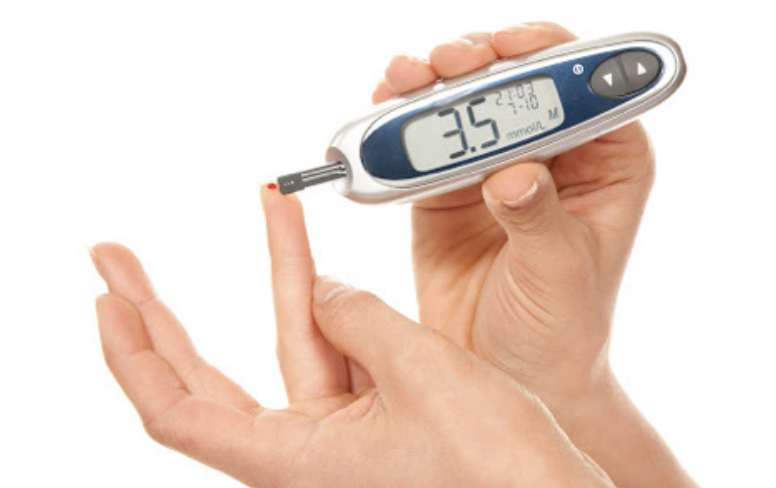Hypoglycaemia in Diabetes
What is hypoglycaemia?
Hypoglycaemia, having a blood sugar that is too low to provide energy for the body’s cells, is defined as a blood sugar level below 4 mmol/L (70mg/dL). The brain needs a continuous supply of glucose to function. Hypos, or hypoglycaemia, can result in symptoms such as confusion and dizziness and can have a pronounced effect on our ability to carry out tasks. If left untreated, prolonged hypoglycaemia can result in serious long-term complications.
Whilst many of us think of diabetes as being a problem of high blood sugar levels, the medication some people with diabetes take, particularly insulin, can also cause sugar levels to drop too low. Hypos are more common in people with type 1 diabetes but can occur in people with type 2 diabetes who are insulin-treated or who are on some diabetes medication such as gliclazide or glimepiride.

Hypoglycaemia in Diabetes
Why does hypoglycaemia happen?
Hypos can occur for the following reasons:
- Taking too high a dose of insulin or diabetes medication.
- Too little food/missed or late meals
- Increasing exercise or physical activity without eating more or adjusting your medications
- Drinking alcohol
- Hot weather or after a hot bath
- Sometimes hypos happen with no obvious underlying cause.
What are the symptoms of hypoglycaemia?
Hypoglycaemia symptoms vary from person to person. However, you will often recognise your own warning signs that indicate your blood glucose level is too low. You may have symptoms such as:
- Hunger
- Shaky / dizzy / sweaty
- Feeling anxious or irritable
- Looking pale
- Tingling of lips / fingers.
Other people may notice that you are:
- Uncoordinated/clumsy
- Irritable
- Not able to speak
- Having night sweats
Hypos must always be treated quickly because if left untreated, can progress to:
- Confusion
- Fits
- Drowsiness or even loss of consciousness
What should you do if you develop a hypo?
- STOP what you are doing. Never ignore the warning signs – act immediately to treat the hypo.
- Eat or drink 15-20g of fast-acting carbohydrates such as:
- 6 glucose tablets
- 5 glucotabs
- 5 jelly babies
- 220mls Lucozade® Original
- 170mls pure orange juice
- 180mls Lemonade/cola (full sugar)
- 2 tubes of GlucoGel®
These are rapidly absorbed and easily converted to sugar in the body.
- Check blood glucose level 10-15 minutes later. If your sugar is still below 4mmol/l then repeat step 2 and recheck your blood sugar after another 15 minutes.
- Once you have treated your hypo you will need to have a longer-acting “starchy” carbohydrate food to prevent it from happening again such as:
- Half a sandwich
- Fruit
- Cereal
- Biscuits and milk
- Next meal (if due)
If you are hypo but confused or drowsy you will need someone to help you. Glucose gels such as Glucogel may be used if you are unable to swallow but are still conscious but should not be given by mouth if you are unconscious. If you are unconscious your family or friends should call an ambulance or give an injection of glucagon (if they have been shown how to do so).
After the hypo – what should you do to minimise your risk of further hypos?
Ask yourself why you had the hypo. If there is an obvious cause, try not to let it happen again for example:
- You may need to eat more carbohydrate before and after physical activity. Adjust your medication or you may need to eat more carbohydrate before and after physical activity. Insulin or medication dose adjustment depends on the blood sugar test results and the type and length of the activity.
- Keep to sensible alcohol limits and do not drink on an empty stomach. Eat a meal or snack with alcohol, if you choose to drink.
- Take your medication at the recommended dose and times.
- Follow the dietician’s advice and maintain regular eating habits. Don’t skip or delay meals or snacks.
- Be familiar with the warning symptoms of hypoglycaemia. This way, you can get treatment quickly. When in doubt, measure your blood sugar levels.
- Always carry a sugary drink, fruit juice or glucose tablets so you can treat symptoms early.
- Measure your blood sugar levels regularly. See if there is a pattern emerging. Are your hypos at a particular time of day? Discuss this with your diabetes team as you may need a change in medication or your insulin regimen adjusting.
- Do not drive if your blood glucose level is less than 5 mmol/L. If you have a hypo while driving, stop the car as soon as possible. Remove the keys to demonstrate you are not in charge of the car, and move into the passenger seat if safe to do so. Treat the hypo as advised. You should not drive for at least 45 minutes after recovery because your response rates will be slower.
- Carry an identity card or medical bracelet in an emergency – others will know that you have diabetes.
- If you have repeated hypos please speak to your healthcare team to help you find ways to minimise hypoglycaemia.
- Sometimes people who have had type 1 diabetes for a long time and have regular hypos may only have a few symptoms and discover that they are having a hypo when they test their blood glucose level. This is called loss of hypo awareness and is potentially dangerous. If you think that this applies to you, it is essential that you contact your diabetes team as there are steps you can take to help restore your awareness of hypos.
Resources:
 Dr Mohgah Elsheikh MBBCh, FRCP
Dr Mohgah Elsheikh MBBCh, FRCP



